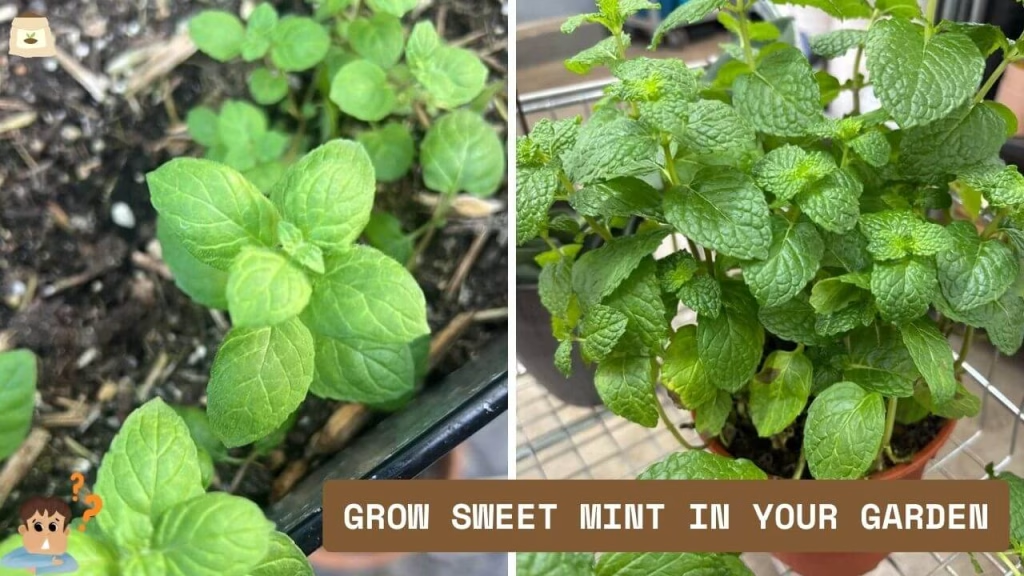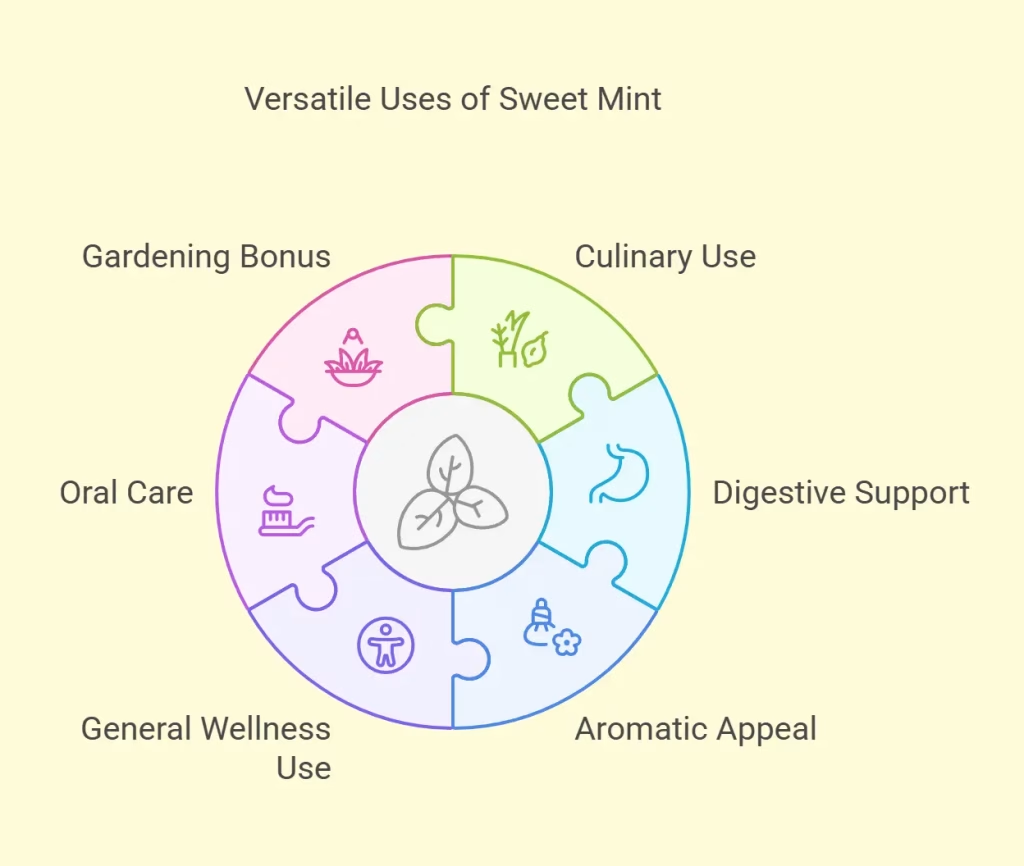What is Sweet Mint? Everything You Need to Know
What is sweet mint? You may ask. Well, it’s more than just your ordinary garden herb. In this guide, you’ll discover its flavor, uses, and how to grow it successfully in your own herb garden. So, keep reading and enjoy the journey.
What is Sweet Mint?
Sweet mint, scientifically known as Mentha spicata, is a fragrant herb appreciated for its aromatic leaves and a variety of everyday uses. This member of the mint family is loved for its fresh, sweet, and mildly peppery flavor.
It differs from other types like spearmint or peppermint thanks to its distinct taste. In the garden, sweet mint thrives in well-drained soil with partial sunlight. It’s a hardy perennial, simple to grow, and spreads quickly, ideal for both new and experienced gardeners.
Aside from its beauty in the garden, sweet mint is often used in drinks, salads, and light desserts. It also has a long-standing history in traditional herbal practices, particularly for soothing the stomach.
Whether you’re into cooking, gardening, or simply enjoy fresh herbs, sweet mint adds vibrant flavor and fragrance to your routine.
How to Identify Sweet Mint?
Recognizing sweet mint (Mentha spicata) is useful for gardeners and herb lovers. Here’s how to spot it:
- Leaves
- Shape: Oblong or lance-shaped with serrated edges
- Color: Bright green, sometimes with a purplish tint
- Texture: Slightly fuzzy, especially on the undersides
- Size: 1 to 2.5 inches long
- Aroma – Crush a leaf gently to release its sweet, mildly peppery scent.
- Growth HabitGrows low and spreads, forming bushy clumpsTypically reaches 12 to 24 inches tall
- FlowersSmall and pale pink to lavenderTubular and grow in whorls
- Stems – Square stems, like other mint family members
- Taste – Mellow and sweet-gentler than peppermint
- Companions in the Garden – Often grown near herbs like basil or oregano
- Habitat – Grows well in home gardens and sometimes wild in cooler climates
Types of Sweet Mint Plant
Well, what is sweet mint? Sweet mint (Mentha spicata) is a widely cultivated herb that includes several cultivars and varieties, each with its unique characteristics and uses. Here are some common types of sweet mint plants:
Standard Sweet Mint (Mentha spicata)
This is the classic sweet mint variety, known for its refreshing, slightly sweet flavor and fragrance. It has green leaves and is commonly used in a variety of culinary applications, including desserts, teas, and cocktails.
Spearmint (Mentha spicata var. crispa)
Often considered a type of sweet mint, spearmint is known for its distinctive, slightly serrated leaves and a sweeter, milder flavor compared to peppermint. It’s a popular choice for making mint juleps, mojitos, and Middle Eastern dishes.
Moroccan Mint (Mentha spicata var. crispa ‘Moroccan’)
This variety of sweet mint is known for its bold, intense flavor and aroma. It’s a common choice for making traditional Moroccan mint tea, where it’s combined with green tea, sugar, and hot water.
Chocolate Mint (Mentha × piperita ‘Chocolate’)
While not a pure sweet mint, chocolate mint is a hybrid that combines the flavors of peppermint and spearmint with a hint of chocolate. Its leaves have a chocolatey aroma, making it a unique addition to desserts and beverages.
Pineapple Mint (Mentha suaveolens variegata)
Pineapple mint is a variegated sweet mint variety with green and white-striped leaves. It has a mild, fruity flavor reminiscent of pineapples. It’s often used in salads, fruit dishes, or as a garnish.
Apple Mint (Mentha suaveolens)
Apple mint is another sweet mint variant with a mild, fruity aroma reminiscent of apples. It’s suitable for various culinary uses, including making herbal teas and adding flavor to sauces and drinks.
Orange Mint (Mentha × piperita ‘Citrata’)
This sweet mint variety has a subtle citrusy scent and flavor, with hints of orange. It’s a lovely addition to both sweet and savory dishes, as well as herbal teas.
Grapefruit Mint (Mentha × piperita ‘Grapefruit’)
With a zesty grapefruit aroma and flavor, this sweet mint cultivar is often used to add a refreshing citrus twist to salads, desserts, and beverages.
Lime Mint (Mentha × piperita ‘Lime’)
Lime mint has a zesty lime scent and flavor, making it a great choice for cocktails, fruit salads, and herbal infusions.
Curly Mint (Mentha spicata ‘Crispa’)
This sweet mint variety is known for its curled or crinkled leaves, which add an interesting texture to dishes. It has a classic sweet mint flavor and is used in various culinary applications.
Sweet Mint vs Spearmint: Differences
Understanding the differences between sweet mint and spearmint is major for herb enthusiasts and gardeners. Below, we’ve compiled a table highlighting the key distinctions between sweet mint vs spearmint varieties.
| Characteristic | Sweet Mint (Mentha spicata) | Spearmint (Mentha spicata var. crispa) |
| Flavor and Aroma | Mildly sweet, sometimes peppery | Distinctly sweet, mild, and refreshing |
| Leaf Appearance | Bright green, smooth-edged | Bright green, slightly serrated edges |
| Culinary Use | Versatile in both sweet and savory dishes | Commonly used in beverages and desserts |
| Popular Dishes | Used in a wide range of recipes, including teas, cocktails, salads, and desserts | A preferred choice for mint juleps, mojitos, and Middle Eastern dishes |
| Fragrance | Generally less fragrant than spearmint | Has a strong, pleasant aroma |
| Varieties | Various cultivars are available, including Moroccan mint, chocolate mint, pineapple mint, and more | Varieties primarily include garden spearmint and curled spearmint |
| Native Range | Native to Europe and Asia | Native to Europe and Asia |
| Essential Oil Content | Lower essential oil content | Higher essential oil content |
| Ornamental Use | Often grown for its culinary uses and aromatic leaves | Primarily grown for its aromatic qualities and traditional culinary applications |
| Appearance in Gardens | Grows as a low-spreading herb with medium-sized leaves | Typically forms dense clumps with slightly taller stems and serrated leaves |
| Popular Combinations | Blends well with other herbs and flavors in various cuisines | A preferred mint variety for mint-based beverages and desserts |
Looking to give your sweet mint a fresh start? Also, consider exploring our article on alternatives for your Earthbox Replant Kit for an exciting way to rejuvenate your herb garden
What is Sweet Mint used for?
Sweet mint (Mentha spicata) offers a range of benefits, including culinary and aromatic properties. Here are some of the key benefits of sweet mint:
- 1. Culinary Use
Sweet mint pairs well with sweet or savory dishes. It’s great in teas, chilled drinks, fruit salads, and desserts. - 2. Digestive Support
Traditionally used to ease occasional stomach discomfort. - 3. Aromatic Appeal
Its refreshing scent is perfect for homemade sachets or natural air fresheners. - 4. General Wellness Use
Mint has long been used in simple home remedies, thanks to its cooling effect and fresh scent. - 5. Oral Care
Fresh leaves can freshen breath. It’s also a common flavor in toothpaste and mouthwash. - 6. Gardening Bonus
Mint can help repel certain garden pests and thrives with little upkeep.
Growing Sweet Mint Plant
Growing sweet mint (Mentha spicata) is a rewarding experience, as this aromatic herb is relatively low-maintenance and can thrive in various conditions. Here’s a step-by-step guide to help you successfully grow sweet mint:
Choose the Right Location
- Sweet mint prefers partial to full sunlight, ideally receiving at least 4-6 hours of sunlight per day.
- Select a location with well-drained soil that is rich in organic matter. Mint can tolerate a variety of soil types, but it thrives in soil with good drainage.
Planting Sweet Mint
- Mint can be grown from seeds, cuttings, or transplants. Transplants are the most common and convenient option for beginners.
- Plant sweet mint in the spring, once the threat of frost has passed.
- Dig a hole or prepare a container that is at least 12 inches deep to accommodate the mint’s spreading root system.
- Space multiple mint plants about 18 inches apart to prevent overcrowding.
Soil Preparation
- Amend the soil with organic compost or manure to improve fertility and moisture retention.
Watering
- Keep the soil consistently moist but not waterlogged. Mint likes evenly moist soil.
- Water at the base of the plant to avoid wetting the leaves, which can reduce the risk of fungal diseases.
- In hot weather, mint may require more frequent watering.
Mulching
- Apply a layer of mulch around the base of the plant to help retain moisture, regulate soil temperature, and prevent weeds.
Pruning and Harvesting
- Prune sweet mint regularly to encourage bushier growth and prevent it from becoming leggy.
- Harvest mint leaves as needed throughout the growing season. Snip leaves from the top of the plant, leaving a few inches of growth intact.
Fertilizing
- Mint doesn’t typically require heavy fertilization. A balanced, all-purpose fertilizer applied once in the spring is usually sufficient.
Container Gardening
- Mint can be grown in containers, which is an excellent option for controlling its growth and preventing it from spreading aggressively in your garden.
- Use a well-draining potting mix, and choose a container with drainage holes.
Pests and Diseases
- Mint is generally resistant to many pests’ but occasional issues may arise. Keep an eye out for aphids, spider mites, and rust.
Propagation
- You can propagate sweet mint by taking stem cuttings and rooting them in water or a soilless mix.
Overwintering
- In cold climates, mint may go down in the winter and re-emerge in the spring. You can mulch around the base of the plant to provide some protection.
Can You Use Miracle-Gro for Growing Sweet Mint?
If your sweet mint seems slow to grow or looks a bit pale, a general-purpose plant food may help support its health. Products like Miracle-Gro can be used in moderation to provide essential nutrients, especially when sweet mint is grown in containers or less fertile soil.
Look for a balanced, water-soluble fertilizer and apply it at a diluted rate-typically once every 4 to 6 weeks during the growing season. Over-fertilizing can reduce the strength of the mint’s natural flavor, so it’s best to use plant food sparingly.
Fertilizer is just one factor in keeping sweet mint leaves fresh. Sunlight, well-draining soil, consistent moisture, and regular pruning all work together to support vibrant growth. So, when used carefully, a nutrient boost can be part of a well-rounded approach to mint care.
Common Problems and Solutions Related to Sweet Mint Plants
Common problems and solutions related to sweet mint plants include various pests, diseases, and other issues. Here’s a list of problems and their respective solutions:
| Issue | Cause | Solution |
| Yellowing Leaves | Overwatering, poor soil | Improve drainage, adjust water |
| Mildew | High humidity | Increase airflow, avoid wet leaves |
| Aphids | Insect pests | Use neem or insecticidal soap |
| Spreading Too Much | Natural growth | Use pots or root barriers |
Is Black Kow Good for Sweet Mint?
Yes, Black Kow composted manure can be a great natural option for enriching the soil where sweet mint grows. This organic compost improves soil texture, adds slow-release nutrients and helps retain moisture-important factors for fresh mint plants.
As a soil amendment, Black Kow works well when mixed into garden beds or containers before planting. It’s a natural fertilizer that’s especially helpful if your soil lacks organic matter. Sweet mint thrives in soil that’s rich, well-draining, and full of life, exactly what Black Kow helps create.
For best results, combine it with other good practices like proper watering, pruning, and sunlight exposure. Used as part of a balanced approach, Black Kow supports steady, leafy growth and vivid flavor.
FAQs
What are the sweet mint recipes?
Sweet mint can enhance a variety of culinary creations. Try it in refreshing beverages like minty mojitos, iced tea, or a classic mint julep. Also, it shines in desserts, like mint chocolate chip ice cream, fruit salads, or as a garnish for chocolate-based treats.
Does sweet mint have flowers?
Yes, sweet mint (Mentha spicata) does produce flowers. Sweet mint flowers are typically small and tubular, arranged in whorls along the stems. They can range in color from pale pink to lavender and are known to attract pollinators like bees and butterflies when in bloom.
Is it possible to grow sweet mint seeds into plants?
Yes, it is possible to grow sweet mint from seeds. However, it can be a bit challenging compared to propagating from cuttings or transplants.
Is Black Kow good for sweet mint?
Yes, Black Kow compost is a natural way to enrich soil for sweet mint. It improves drainage, boosts nutrients, and helps retain moisture.
Are you interested in plant-care and remedies? Here is another article that will help you to discover about Epsom salt’s effects on plants.








